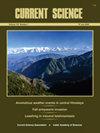Understanding dietary differences in Indian dugongs through opportunistic gut sampling of stranded individuals
IF 1
4区 综合性期刊
Q3 MULTIDISCIPLINARY SCIENCES
引用次数: 0
Abstract
We analysed gut samples of stranded dugongs from Tamil Nadu and Gujarat, India, to understand their die - tary preferences. We quantified seagrass fragments from the gut as leaf, stem and rhizome, and identified leaf fragments up to genera level by their morphological features and epidermal cell characteristics using an inverted microscope. The overall abundance of above-ground fragments (leaf, stem) was higher in all samples , which may suggest the dugongs use a cropping mechanism to forage. The ingested seagrass generic diversity was higher in Tamil Nadu ( n = 5) dugong individuals than those in Gujarat ( n = 2). A total of five genera were recorded from all samples, viz. Halophila spp., Halodule spp., Cymodocea spp., Enhalus sp. and Syringodium spp. In Tamil Nadu, Cymodocea spp. (46.24%) was the most dominant, followed by Halophila spp. (26.49%), Syringodium spp. (14.83%) and Halodule spp. (12.16%), with a low occurrence of Enhalus spp. (0.19%). In Gujarat, Halodule spp. (61.48%) was the most dominant, followed by Halophila spp. (30.20%). The recorded plastic and wood fragments suggest fine spatial scale threat mapping in dugong habitats.通过对搁浅个体的肠道取样了解印度儒艮的饮食差异
我们分析了来自印度泰米尔纳德邦和古吉拉特邦的搁浅儒艮的肠道样本,以了解它们的死亡偏好。我们将肠道海草碎片量化为叶片、茎和根茎,并利用倒置显微镜对叶片碎片的形态特征和表皮细胞特征进行了属级鉴定。在所有样本中,地上碎片(叶、茎)的总体丰度都较高,这可能表明儒艮采用了一种种植机制来觅食。泰米尔纳德邦(n = 5)儒艮的海草属多样性高于古特拉邦(n = 2),所有样本共记录到5个属,分别为Halophila spp、Halodule spp、Cymodocea spp、Enhalus spp和Syringodium spp,其中泰米尔纳德邦以Cymodocea spp(46.24%)最占优势,其次为Halophila spp(26.49%)、Syringodium spp(14.83%)和Halodule spp (12.16%), Enhalus spp的发生率较低(0.19%)。古吉拉特邦以Halodule属(61.48%)和Halophila属(30.20%)为优势种。记录的塑料和木材碎片显示了儒艮栖息地精细的空间尺度威胁映射。
本文章由计算机程序翻译,如有差异,请以英文原文为准。
求助全文
约1分钟内获得全文
求助全文
来源期刊

Current Science
综合性期刊-综合性期刊
CiteScore
1.50
自引率
10.00%
发文量
97
审稿时长
3 months
期刊介绍:
Current Science, published every fortnight by the Association, in collaboration with the Indian Academy of Sciences, is the leading interdisciplinary science journal from India. It was started in 1932 by the then stalwarts of Indian science such as CV Raman, Birbal Sahni, Meghnad Saha, Martin Foster and S.S. Bhatnagar. In 2011, the journal completed one hundred volumes. The journal is intended as a medium for communication and discussion of important issues that concern science and scientific activities. Besides full length research articles and shorter research communications, the journal publishes review articles, scientific correspondence and commentaries, news and views, comments on recently published research papers, opinions on scientific activity, articles on universities, Indian laboratories and institutions, interviews with scientists, personal information, book reviews, etc. It is also a forum to discuss issues and problems faced by science and scientists and an effective medium of interaction among scientists in the country and abroad. Current Science is read by a large community of scientists and the circulation has been continuously going up.
Current Science publishes special sections on diverse and topical themes of interest and this has served as a platform for the scientific fraternity to get their work acknowledged and highlighted. Some of the special sections that have been well received in the recent past include remote sensing, waves and symmetry, seismology in India, nanomaterials, AIDS, Alzheimer''s disease, molecular biology of ageing, cancer, cardiovascular diseases, Indian monsoon, water, transport, and mountain weather forecasting in India, to name a few. Contributions to these special issues ‘which receive widespread attention’ are from leading scientists in India and abroad.
 求助内容:
求助内容: 应助结果提醒方式:
应助结果提醒方式:


